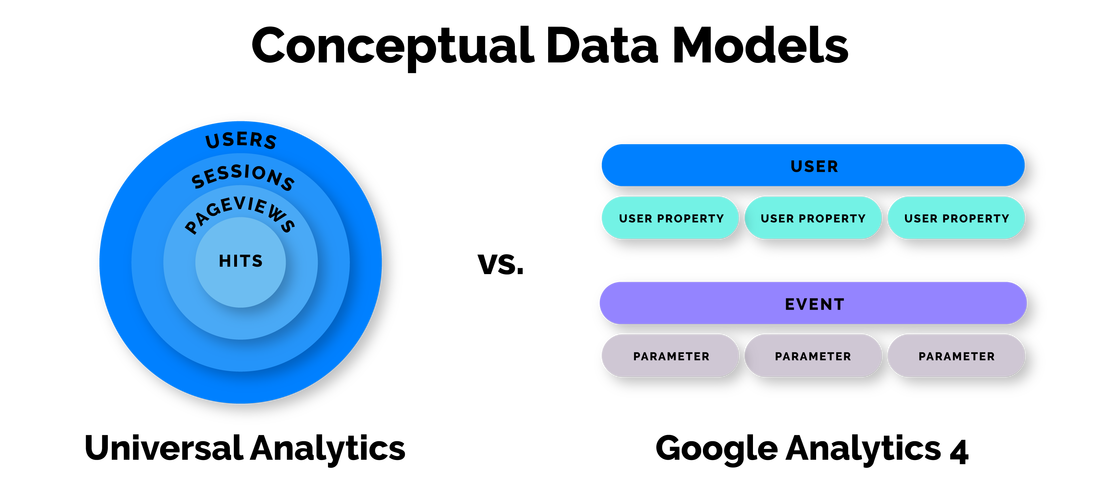
Since it was announced by Google in October of 2020, Google Analytics 4 (GA4) has received lots of attention - most of it negative. GA4 seeks to make a clean break with its predecessor Universal Analytics (UA or GA3), and its approach to accomplishing this clean break has left lots of long-time users feeling abandoned and out in the cold. Released in October of 2012, GA3 provides an all-in-one tool, with metrics configuration, collection, and reporting all built into a single interface, with established best practices, templates, and tutorials built by the community over the decade.
By comparison, GA4 is currently in a state that might feel like “open beta.”
At present, GA4 does not have many of the key features present in Universal Analytics, notably Views, Content Groupings, and Filters and its native reporting capabilities are not as comprehensive as those found in GA3. However, many of those features aren’t missing - they are often intentionally excluded, and offloaded to other tools better suited to those particular tasks.
Regardless, for many marketers who’d grown accustomed to GA3, GA4 feels like starting over from scratch.
Rather than focusing on what it is not, marketers and publishers should focus on what GA4 is - a remarkable, privacy-aware analytics engine built atop a modern architecture intended to be deployed as part of the broader Google Marketing Platform. This architecture allows you to combine your website and mobile app metrics and unify authenticated users across those digital experiences. Yes, GA4 is still having growing pains, and is missing a few key features, but it shows remarkable promise. Now is the time to capture that promise.
Below, we’ll give you some advice on how to do that, but first here’s some good news.
Introducing Google Analytics 4 Features
Even with its absent features and the negative reaction of the community, we do recommend that our clients deploy GA4, because of the promise we see in the software. There are some exciting features present for data analysts and marketing campaign managers.
Improved Events Tracking
Analysts have long felt constrained by UA’s approach to event tracking, which is limited to four values: Category, Action, Label, and (Dollar) Value. Site owners have to get creative if they want to collect more detail about an audience engagement event, and analysts often find themselves having to heavily caveat their insights and recommendations. GA4 uses the industry-standard events/parameters approach, which removes the old Category/Action/Label constraint and provides greater flexibility.
Now, users can configure events with up to 500 unique events, with 25 parameters for each event.
There are four categories of events that can be sent to Google Analytics, including:
Improved Identity Management and Audience Segment Tracking
GA4 improves on the User-ID audience tracking feature established in Universal Analytics. UA allows you to analyze anonymous users in one place (via Client-ID), but forces you to analyze “authenticated” users separately, and only if you have configured UserIDs.
GA4 uses a cascading approach: it uses your own UserIDs first, then Google Signals (Google Identity Graph, based on a user’s Google account), and then anonymous ClientIDs. This means that GA4 allows for a cross-platform, cross-device view of your visitors' behavior, which is vital in today’s world, where customers flow smoothly from desktop to laptop to mobile device. The addition of Google Signals into the resolution scheme allows you to segment your users based on common characteristics or behaviors and then export those to Google Ads network for remarketing.
Predictive Audiences and Metrics
Google Analytics 4 introduces Artificial Intelligence (AI) and Machine Learning (ML) to its analytical engine. By collecting structured data about your audiences’ engagement habits, you can bring the power of AI/ML to bear on your customer data, and uncover predictive insights like purchase probability, user churn probability, and revenue prediction. Predictive insights can help you transform historical data into outcomes, so you can make more informed decisions about your content and campaign strategies, and uncover new avenues of user engagement.
In addition, Google has introduced predictive audiences, which are based on those predictive analytics and can be used in advertising, remarketing, and re-engagement campaigns. While these capabilities are in their infancy, as the platform matures, we are sure to see more predictive metrics make their way into the experience.
Ad Hoc and Retroactive Analysis in Exploration Hub
The most exciting addition for Google Analytics 4 is the introduction of the Exploration Hub. It brings to the standard version of Google Analytics some features (such as funnels) that were previously only available in the premium GA360. While Google does recommend that deep analysis is performed in a separate Business Intelligence (BI) tool, like Google Data Studio, the exploration hub is powerful for ad hoc analysis. Google describes those capabilities as:
Understanding the Event-Based Measurement Model
All of those exploration and analysis features are possible because of perhaps the biggest change in GA4 - how it collects your web data. In Universal Analytics, metric collection relies on a few measurement “objects” or “scopes” and is conceptually centered around the pageview. In this page-based model:
In Universal Analytics, understanding and interpreting audience behavior relies on detailed analysis of these objects, how each functions in the hierarchy, and relies on users traversing a website from page to page. Universal Analytics pre-defines the types of hits one can collect (pageviews, ecommerce transaction, social interaction, etc.), which means that publishers sometimes find themselves creating content based on what UA can measure, rather than what is best for their audiences.
Further, these metrics are often collected in silos, which limits our ability to conduct deep session and engagement analysis across those silos - for example a user’s session with multiple hits, events, and goal conversions - especially if that session spanned two different days. This may be appropriate for traditional content-publishing websites, but is less useful for single-page applications or mobile apps, which often take place as one long scroll. (How many pageviews does Instagram get?)

However, GA4 now uses a modern events-based measurement model, where every action, including the pageview, is now considered an event. In fact, Google Analytics 4 only has two measurement objects - Users and Events. Users have Properties, such as Age or Country, and Events have Parameters, such as a transaction price, or a document download file type. This simplified model eliminates the limitations imposed by the hierarchical UA approach and allows you to conduct a much more flexible analysis of your customer behavior.
Unfortunately, this simplified approach means that data collected by GA3 in the page-based model is not compatible with data collected by GA4 and its events-based model.
To ease the transition into this fully events-based model, GA4 automatically collects some common events via enhanced measurement, such as pageviews, scroll-tracking, file d0wnloads, and outbound clicks. While these events may cover the basic data points necessary for analysis, you’ll need to create a personalized GA4 tag implementation plan if you want to get the most out of your investment. Our Customer Data and Insights team can help you create that plan.
Implementing and Using GA4
It’s important to understand the underlying events model, and the separation between collection, reporting, and analysis because they inform how marketers and publishers should deploy and use GA4.
With few exceptions, we recommend that you deploy a GA4 property alongside your current Universal Analytics property and begin gathering data, so that as Google releases new GA4 features, you are positioned to take advantage of those features. Data collected by GA4 is not backwards-compatible with the GA3 data (more on that later), so configuring the site to capture both GA3 and GA4 (a dual-tagging approach) ensures that you have historical data in GA3, more detailed and simplified tracking in GA4, and continuity in metrics collection between GA3 and GA4.
We recommend the following approach:
Taking the First Step Now
We expect that Universal Analytics will be around for three to five more years; however, during that time GA4 will mature and slowly supplant UA as the default tool of choice for marketers, publishers, and analysts. We recommend that clients begin the migration to Google Analytics 4 now, rather than waiting for UA to sunset. This will allow marketing and content operations teams to build familiarity with the new interface, build expertise in the expanded Google Marketing Platform toolsets, and most importantly, collect detailed event and user data in the GA4 measurement model.
Converting from GA3 to GA4 is not a traditional upgrade. For many, it represents a new way of thinking about marketing analytics and will require adapting internal processes, learning new technology, and being more thoughtful about how and why you collect customer data. In practice, this means that managing analytics in GA4 requires more upfront (and ongoing) planning than in GA3. It also suggests a need for familiarity and competence (if not expertise) with each of the associated tools to ensure your data infrastructure is set up for future scalability and sustainability.
This is a lot to digest and likely feels like a daunting enterprise. Phase2 has a dedicated Customer Data and Insights team that can provide consultation and set you on the path of marketing analytics best practices.
We hope you enjoyed reading the Phase2 blog! Please subscribe below for regular updates and industry insights.
Jason Hamrick
DIRECTOR, DATA & INSIGHTS
The original version of this page was published at: https://www.phase2technology.com/blog/why-marketers-publishers-and-analysts-should-start-using-google-analytics-4
From engineering interconnected patient experiences to designing new digital platforms, our experience with hospitals and healthcare systems is extensive and touches on every facet of the business.
At Phase2 we are united in our approach to accessibility—working together as both advocates and practitioners because we believe that creating accessible user experiences is ...read more
Whether you’re a UI Designer, a Developer or simply someone that has an appreciation for quality digital experiences, this podcast should be valuable to you! At Phase2, we pride ...read more
In the wake of the past three years, healthcare talent acquisition has become an urgent need. With an increasingly competitive environment, leading healthcare systems are breaking ...read more
Top health organizations name Customer Experience (CX) as their top strategic performance measure. Proven to increase loyalty, drive revenue, and boost lifetime value, CX has been ...read more